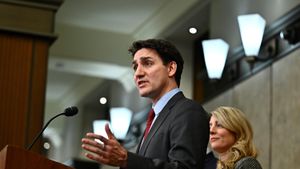U.S. President Donald Trump recently kicked off his protectionist trade policies with sweeping new tariffs on imports from key trading partners, including Mexico, Canada, and China. This move, announced on February 1, has not only rattled the financial markets but has also sparked significant backlash from global leaders and businesses, raising fears of economic retaliation.
The tariffs involve a staggering 25% levy on imports from Canada and Mexico, along with a 10% tariff on goods from China. Trump, maintaining his defiant stance, claimed these measures are necessary to protect American workers and industries, alluding to what he described as “unfair” trade practices. The response from stock markets was immediate and severe, with global indices experiencing sharp declines.
Global reaction was swift: Canadian Prime Minister Justin Trudeau denounced the tariffs and announced retaliatory measures affecting $155 billion worth of American goods, including popular items like beer and household appliances. Meanwhile, Mexican President Claudia Sheinbaum also proclaimed countermeasures, targeting significant American exports such as steel and dairy products. The leaders of both countries emphasized the need for negotiation over confrontation, with Trudeau warning of potential long-term impacts on North American trade.
Concerns abound not only about the immediate effects but also about the long-term economic repercussions, especially concerning rising prices for American consumers. Analysts predict significant price hikes on consumer electronics, vehicles, and agricultural products, which are primarily sourced from the affected nations. The recent tariffs will inevitably lead to higher costs for U.S. households as businesses pass on the additional expenses.
The overall economic impact could be considerable. According to sources, analysts expect the tariffs to affect nearly half of all U.S. imports, compelling the country to nearly double its domestic manufacturing output—a challenging prospect. Economists warn this could push Canada and Mexico toward recession, increasing the risk of “stagflation” within the U.S. economy, where inflation spikes occur alongside stagnant growth.
During this pivotal moment, Trump reiterated his belief in the long-term benefits of the tariffs, asserting they were intended to curb immigration and combat drug trafficking. He acknowledged, via social media, the potential short-term pain these tariffs might inflict on consumers and industries, emphasizing, “Will there be some pain? Yes, maybe (and maybe not!). But we will make America great again, and it will all be worth the price.”
Trump's decisions have even stirred concerns within India, which has, for now, been spared from the economic fallout of the tariffs. Indian officials have begun strategizing to counteract potential future measures Trump might impose, particularly as he has previously referred to India as the “tariff king.” India's government is actively preparing for possible tariffs by reviewing goods susceptible to American duties, demonstrating New Delhi’s aim to safeguard its economic interests.
Economic experts, including Ajay Sahai of the Federation of Indian Export Organisations (FIEO), affirm the current scenario presents India with unique opportunities to bolster its share of the U.S. market amid the trade restrictions on China. Yet, the prevailing uncertainty looms large as the potential impact on trade relations between the U.S. and India remains to be seen.
With Trump pledging to uphold these tariffs until key issues such as fentanyl trafficking and trade balances are resolved, industry stakeholders are left bracing for the possibility of enduring trade tensions. While Mexican, Canadian, and Chinese leaders have vowed to respond with countermeasures, there are apprehensions over the potential escalation of economic hostilities, which could lead to unforeseen consequences on global trade.
Despite the tumultuous environment, Trump’s administration claims these tariffs serve as necessary tools to rebalance trade, protect American jobs, and mitigate the challenges posed by global opportunism. A full-scale trade war could disrupt established supply chains, affecting various sectors, particularly those heavily dependent on imports from neighboring countries.
The coming months will be pivotal as countries navigate this newfound trade hostility. Proponents and critics alike are watching closely how markets react, how retaliatory tariffs reshape commerce, and whether diplomatic channels can stem the tide of what could evolve from a series of tariffs to heightened global trade instability. The stakes are high, as economic diplomacy faces the test of whether it can balance national interests against the fabric of interdependent global trade.



